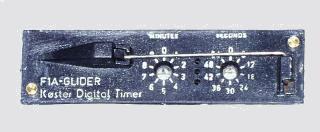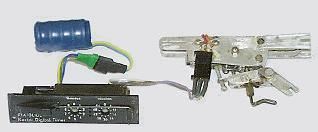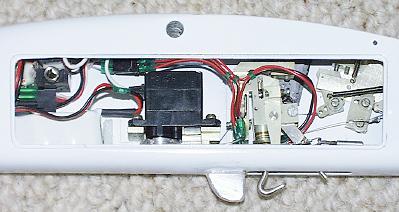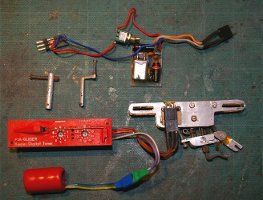Personal experiences
Look up the results for the Sierra Cup in 1983 and you'll see
it was won by Walt Ghio in the 7th (10 minute) flyoff round after
we'd flown 10 normal 3 minute rounds. I was second. Walt was
using an extender disk on his KSB timer and I was using a Koster
electronic. Virtually everybody else had dropped out at the 7 and
8 minute rounds because they were using standard 6 minute KSB
timers (6 mins + time on d/t was less than 8 minutes on that
day). A week earlier Lee Hines and I had whopped the rest of the
field in the F1A Champagne Flyoff at the Livotto (Taft field)
because we were using electronic timers and the rest weren't. Lee
won because his Bauer ran for a bit over 10 mins while my Koster
had a maximum settable time of 9 min 54.
The first electronic glider timers I saw were made by Ken
Bauer, who used a 555 timer chip plus a 2224 programmable
oscillator/divider to drive a magnetic actuator that was
energised during the whole flight. I got two of these in 1982.
They had a few problems: they were not waterproof and the
analogue timing circuit drifted noticeably with temperature. The
lack of waterproofing was a real problem because if the timer got
wet it would only d/t after 10 minutes, though it did always d/t.
The permanently on actuator ate batteries and it was powered by a
9v PP3 battery, which was bulky as well as being insufficiently
dense to act as useful nose weight. That said, they were a fail
safe design and would d/t if the battery failed as well as after
a line break.
I saw the Koster prototypes in France in summer 1982 and got
my hands on some of Thomas' first production batch in early 1983,
in time to use one in my first D-box model. I trimmed it during
that summer and then used it later that year in the Australian
World Champs, the Livotto competition at Taft and the Sierra Cup.
I had both Bauer timers and Kosters in the models I flew that
year.
As far as I'm concerned the first really practical electronic
was the Koster, which came out in early 1983. I'm still using
them in zoom launch models though they have been out of
production since the late 80s. I think that speaks volumes for
their quality and reliability.
|
 
|
|
The Koster timer.
These pictures show the faceplate and a complete system
with original style 50 mAh NiCd battery and a Hatschek
hook. I used Honeywell sealed micro-switches which, with a
pivoted brass tongue between hook and switch, doubled as
the forward hook stop.
|
The Koster is a single function F1A circle tow glider timer,
settable in 6 sec increments up to 9 min 54 secs and designed to
be set/reset from a micro switch that detects when the tow hook
is pulled forward. It has a moulded plastic face plate housing
the d/t release mechanism and the electronics are potted in a
waterproof compound. The timer was designed to fit into the same
space as a Seelig F1A timer, which weighed about 28g, though
without allowing space for the battery and wiring. The Koster
weighs 20g with wiring and also requires a microswitch (2.2g) and
a four or five cell NiCd battery (16 or 20g respectively) for an
installed weight of 36.2 to 42.2g depending on the battery. The
timer draws 80 or 300 uA depending on whether it is being driven
by a 4 or 5 cell battery and requires 500 mA for 15 mS to d/t.
This is a minute power requirement: it has been calculated that
you could make a flight every 5 minutes for 18 hours and still
use only 30% of the battery capacity.
Koster timers are designed around dumb electronics.
Essentially they contain a 32 kilohertz watch crystal, a divider
chain to slow this down to give 6 second 'tick' and two 74LS193
cascaded counters, each connected to a decimal encoded rotary
switch. These select the d/t time in 6 second increments (0-54)
on one dial and minutes (0-9) on the second dial. They are
adjusted with a small screwdriver. The timer pulses a small
solenoid to release the d/t lever. Its main weakness is that it
is not a failsafe design: if there is not enough power in the
battery to trip the solenoid the model will not d/t.
I lost one of my Koster-equipped models at the 1991 Poitou
event on a lunch-time trimming flight when it failed to d/t. Of
course I'd put it in a good thermal: we could still see it
climbing and drifting away as we went out to fly the first round
after lunch. So, although the model was fitted with a 27 MHz Vin
Morgan tracker, there was little point in chasing it since it had
specked out still climbing and the 27MHz Morgan bugs didn't have
a huge range compared with current units. Much to my surprise the
model was found, gift-wrapped and presented to me at the 2009
Poitou prizegiving so I was able to find out why it had flown
away. Judging by the airframe damage the model had landed in a
tree and either fallen or been knocked out of it, since the
tailplane and fin were both missing and the tips were off.
However, apart from that it was in remarkably good condition
apart from rust coated piano wire and steel screws, so it must
have been picked up fairly soon and kept in somebody's house for
the next 18 years. The NiCd battery was long dead and the battery
connections had corroded, but after I cleaned the contacts and
plugged in a battery borrowed from a current model, the timer
worked perfectly and so did the tracker. The model was less than
a year old when it was lost, so it was probably a faulty battery
rather than poor battery connections: at the time I knew very
little about recognising when a battery was about to fail and had
not yet started to keep a log of battery test results. The timer
was one of the original 1983 batch of Kosters: they were the only
ones to have coloured faceplates. That the timer still worked
speaks volumes for the quality of its design and construction. It
went straight back in my spares box to await fitting to another
model.
In 2003 I bought a pair of MTK
timers. One is in an M&K 'short' model and the other is
for future use.
 |
|
The MTK timer.
This shows the timer installed in an M&K fuselage
|
The timer weighs 9.3g and requires a 5 cell 50 mAh NiCd
battery weighing 20g, a sub miniature (9.5g) RC servo to drive
the tailplane and two reed switches (1g) to sense the hook state.
This gives a flying weight of 40g. The timer is much more capable
than the Koster. In addition to line break protection it provides
an arbitrary set of tailplane movements during the bunt launch
and glide, audible timer state indication and the ability to skip
the bunt in the event of a muffed launch. A Palm Pilot is used to
load settings into the timer before flight. The major
disadvantage of this timer is that it will not do more than four
or five launches on a single battery charge. As a result, my
routine involves recharging the flight battery after every
flight.




